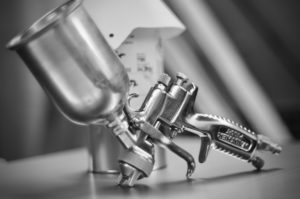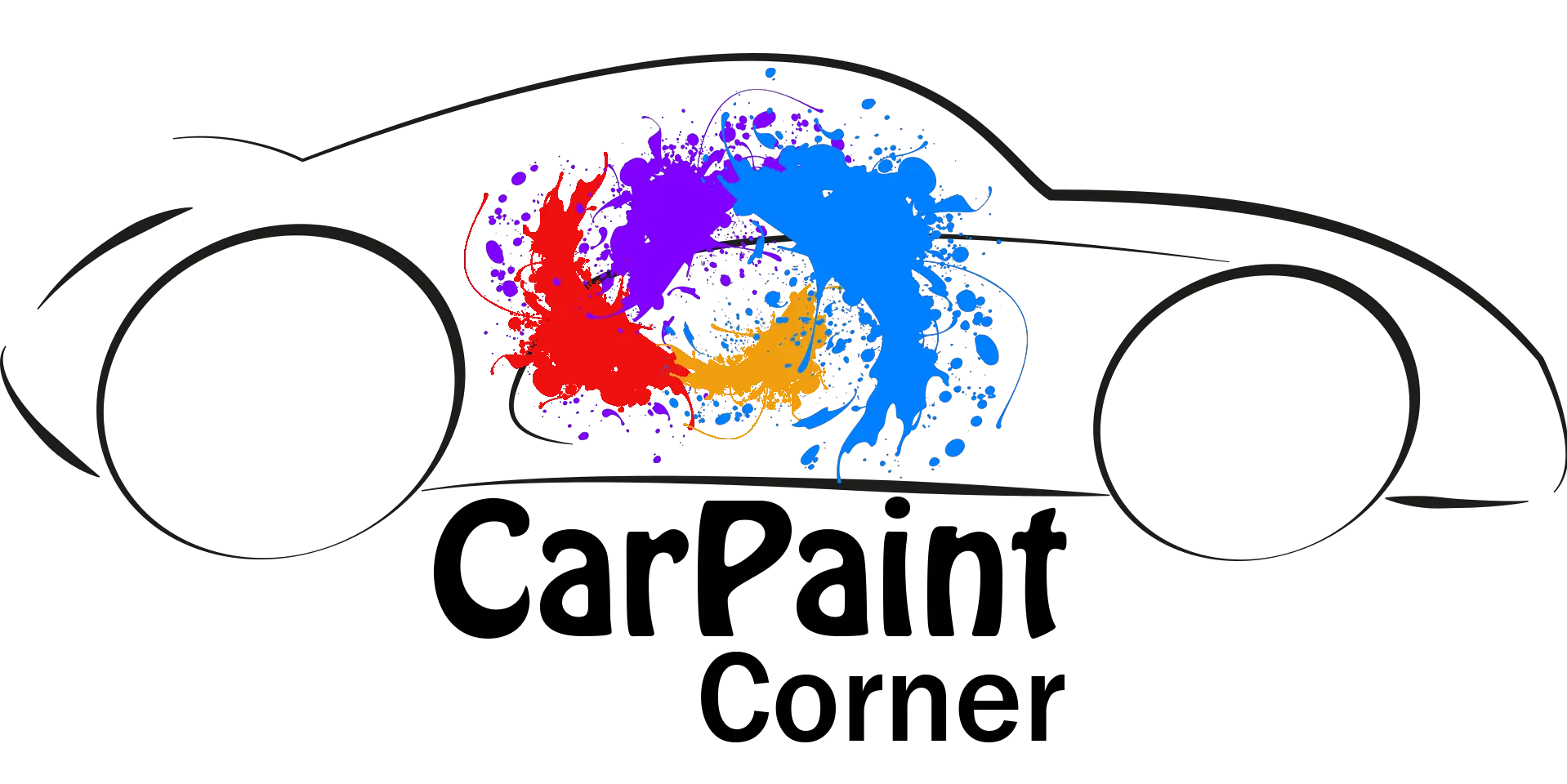This post may contain affiliate links which means I may receive a commission for purchases made through links.

Although there are many types of spray guns available, LVLP and HVLP models are two of the most popular options. So, as you prepare to buy yourself the best car spray for your car painting project, get ready to choose between an HVLP Vs LVLP spray gun.
But, how do you differentiate between an HVLP and LVLP spray gun?
While this may seem like a simple task, choosing between an HVLP and LVLP isn’t always easy, even for professionals and highly experienced DIYers. However, this should not come as a surprise seeing that both tools look almost the same and have pretty much the same applications.
Well, don’t worry though! In this blog post, I’ll show you some of their differences to help you pick the right one for your upcoming painting project!
So, let’s get right into it!
What’s an HVLP spray gun?
HVLP or High Volume Low-Pressure spray guns are some of the most used sprayers around the world.
As the name suggests, these types of spray guns are designed to use very little pressure but produce high-volume output. In short, HVLP spray guns atomize paint at a higher volume compared to LVLP spray guns.
In addition, HVLP spray guns use about 10 PSI or more to lay paint down on the surface. More importantly, this means that they use a lot more air on the fluid tip and spray it on the surface.
For that reason, you’ll need to buy an air compressor when working with these spray guns, unless you have a turbine HVLP sprayer.
Other than that, the overall design and work mechanism of HVLP spray guns make them easier to use, even for inexperienced DIYers and beginners. Not to forget that they waste little material and deliver a better quality finish than conventional spray guns.
To be precise, HVLP uses a lot of volumes and converts them to low pressure, which results in a soft spray. As a result, this reduces overspray and coating waste, thus saving on paint costs.
On the downside, HVLP spray guns require much larger air compressors than LVLP types, meaning the extra cost for the use. In addition, they seem to struggle with thicker paints like zinc and epoxy coatings as they don’t atomize them well. For that, they will be very useful for some projects and professional applications.
Types of HVLP Spray guns
HVLP spray guns can be classified into 2 categories: pneumatic and turbine-driven spray guns.
Turbine-powered HVLP spray guns are the most popular painting tools among DIYers. Thanks to their affordability, ease of operation, and ability to apply paint without the need for an air compressor.
This spray gun usually comes with the turbine powerhouse integrated into the device, allowing you to use it immediately after buying it. However, the device can also come as a floor-standing machine, where the power unit is cased in an external casing.
Either way, HVLP turbines are suitable for medium-scale work like upscaling furniture, weatherproofing decking, and coating fencing.
On the other hand, pneumatic HVLP spray guns resemble LVLP sprayers and require an external air compressor to atomize and propel the coating medium onto the surface.
More notably, they’re equipped with air volume and pressure control and adjustable painting density. As a result, they provide greater versatility than turbine spray guns, making them an excellent option for contractors.
Unfortunately, pneumatic HVLP spray guns are more costly compared to their turbine counterparts, especially seeing that you need an air compressor. In addition, they require a little experience to operate, unlike HVLP turbines which are more user-friendly for beginners.
Advantages of HVLP spray guns
- Less overspray
- Efficient when it comes to spray painting with minimum wastage
- HVLP turbines are highly affordable and easy to operate
- Delivers high-quality finishes
- Fast clean up
- Great transfer efficiency
- Ideal for use on metallic surfaces
Drawbacks of HVLP Spray guns
- Pneumatic HVLP spray guns require an air compressor
- Doesn’t work well with thicker paints
- Requires access to large volumes of air
- Not as fast as airless spray guns
LVLP Spray guns
Unlike HVLP spray guns, Low Volume Low Pressure (LVLP) sprayers work with lower pressure (usually less than 10 PSI) at the nozzle of the device. For that, it’s a perfect choice for users with a smaller air compressor with less volume and for spraying clear coats.
However, while buying an air compressor for an LVLP spray gun, make sure it meets the CFM (airflow) and PSI requirements of your spraying tool.
Another notable benefit of LVLP spray guns is that they provide a superior finish due to their transfer efficiency. Many professionals use them for waterborne paints. Even better, LVLP spray guns work best with thinner paints.
However, if you’re working on sticky surfaces or applying metallic paint, I’d recommend that you use an HVLP spray gun instead.
That aside, LVLP spray guns are relatively faster than their HVLP counterparts, making them more popular with professional users and experienced DIYers. At the same time, they deliver superb material transfer efficiency to reduce waste and require less pressure to function.
Specifically, LVLP sprayers require about 10 PSI on the fluid tip, allowing them to work with almost any type of air compressor out there.
It’s also worth mentioning that, unlike HVLP spray guns, LVLP models are only available as pneumatic units, meaning they need an air compressor to function. So, unless you already own a pneumatic device like a nail gun, power driver, or impact wrench, you’ll need to buy an air compressor to use your LVLP spray gun.
Benefits
- Less overspray
- Delivers a smooth finish
- Uses lower PSI
- Compatible with almost all types of air compressors
- More affordable than HVLP sprayers
- Sprays faster than HVLP units
- Works perfectly with thinner and waterborne paints
- Ideal for applying clear coats
Drawbacks
- Not suitable for spraying thick paint medium
- Smaller fan pattern than HVLP spray guns
HVLP Vs LVLP Spray guns: Notable differences
Transfer efficiency rate
The transfer efficiency rate of paint sprayers tends to vary from one model to another. However, it also depends on whether you’re using an HVLP or LVLP spray gun.
As far as transfer efficiency rate is concerned, an LVLP spray gun does a better job than an HVLP unit as it can transfer up to 80% of the paint medium. This means there will be less paint wastage, making LVLP sprayers a more eco-friendly option.
On the other hand, HVLP spray guns have a transfer efficiency of about 65 – 75%, meaning they’re less efficient than their LVLP counterparts. Nonetheless, HVLP sprayers are a lot better than conventional sprayers which offer a transfer efficiency rate of less than 35%.
Operating Pressure (PSI)
While both LVLP and HVLP require low pressure to function, they have different operating pressure requirements. To be precise, HVLP spray guns require a large air compressor to do the job as they require a large volume of air, but a low pressure.
Most HVLP spray guns work at around 20 CFM & 50 PSI, meaning they’ll need an air compressor with almost an 80-gallon tank. In comparison, LVLP spray guns work at a pressure range of about 10 – 25 PSI and 5 CFM. This makes LVLP a more suitable option as you can use them with any air compressor.
Fan spray width & pattern
Another notable difference between an LVLP and HVLP is the fan spray width and pattern. This factor affects the overall performance as well as the user’s comfort when using a spray gun.
That said, both HVLP and LVLP spray guns deliver a wide range of fan patterns. However, LVLP sprayers usually provide a width of 8 – 10”, which is considered small.
More notably, this increases the time it takes to spray paint a particular surface with the device. Not to forget that a smaller fan pattern range will affect the quality of the finish, especially if you don’t have enough experience.
Other than that, the small and narrow width pattern of LVL sprayers makes them a great choice for smaller jobs and smaller areas.
HVLP spray guns, on the other hand, provide a larger fan spray width and pattern than what LVLP units have to offer. This makes them a better option for large surfaces that need uniform painting and with some speed.
Cost
Seeing that there are various models and brands of both LVLP and HVLP spray guns, their prices tend to vary significantly. However, HVLP sprayers are generally more expensive than their LVLP counterparts.
For instance, the price of buying a quality HVLl sprayer can be over $500, while a quality LVLP spray gun barely goes beyond $400.
Another thing that makes HVLP spray guns even more costly is that they require a larger air compressor, while LVLP can run on any compressor.
Paint Medium
Turbine HVLP spray guns can spray various types of paints including enamel, acrylic, stain, primer, and latex paints. Similarly, most pneumatic HVLP spray guns are ideal for applying multiple coatings including viscous fluid, although some may need thinning.
However, you need to consider the fluid nozzle/ tip of the device before you apply any paint medium, bearing in mind that dense paints require a tip with a larger diameter.
For instance, spraying latex paint requires a nozzle with a diameter of at least 1.6mm. Luckily, most HVLP spray guns come with various fluid tips, allowing you to spray paints of various thicknesses.
In contrast, most LVLP spray guns are ideal for applying enamel, acrylic, lacquer, latex, clear coat, chalk paint, and oil-based paint mediums. In addition, you can use them to spray waterborne coatings and other thinner mediums.
Ease and convenience of use
Since HVLP spray guns are older than LVLP units, they’re easier to use as they have been tested in a better way. In addition, they’re better suited for larger jobs, which is why they’re quite popular among professional painters.
On the other hand, LVLP guns aren’t easy to use unless you have previous experience since they’re relatively new to the market. Plus, they tend to clog in some instances and require to be refilled more often.
Which is better: HVLP vs LVLP spray gun?
Both LVLP and HVLP spray guns are quite efficient and perform fantastic spray-painting jobs. However, both guns work on different mechanisms and are therefore ideal for different applications and scenarios.
For instance, an HVLP sprayer is ideal for users who don’t have much experience in spray painting as they’re more user-friendly. However, they’re suitable for DIY projects since they have a lower transfer efficiency rate.
As a result, they’re not recommended for professional applications as they tend to waste materials, which can significantly increase the overall cost of the project.
In comparison, LVLP spray guns are not a great choice for DIY projects and users who have little spray painting knowledge. Moreover, they’ve got a steep learning curve since they’re not that common.
On the bright side, LVLP spray guns waste a lot fewer materials and require small air compressors, making them ideal for professional applications. Plus, they’re portable, spray super fast, and have an incredible transfer efficiency rate!
Read next: How to set up the perfect pressure for your paint sprayer.


Leave a Reply